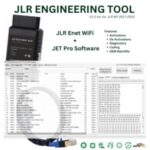Experiencing issues with your 2004 Honda Civic passing an emissions test can be frustrating. One common hurdle is related to OBD-II readiness monitors not being in a “ready” state. These monitors are crucial for verifying your vehicle’s emission control systems are functioning correctly. If they are not ready, your Civic might fail the smog test, even if there isn’t a major underlying problem. A key step in addressing this is understanding your 2004 Honda Civic Obd2 Port and how to perform an OBD-II drive cycle. This process can often reset these monitors, preparing your car for a successful emissions test.
First, let’s locate the OBD2 port on your 2004 Honda Civic. This diagnostic port is a standardized feature in all cars manufactured after 1996 and is essential for accessing your vehicle’s computer system. For the 2004 Honda Civic, you will typically find the OBD2 port located underneath the dashboard on the driver’s side. Look for it in the vicinity of the steering column, often near the hood release lever or around the fuse box access panel. It is usually not hidden behind a panel but is openly accessible for easy connection with a diagnostic scanner. The port is trapezoidal in shape and has 16 pins. Once you’ve located the 2004 Honda Civic OBD2 port, you’re ready to understand how to use a drive cycle to potentially resolve your readiness monitor issues.
The OBD-II drive cycle is a specific set of driving conditions designed to allow your 2004 Honda Civic’s onboard computer to run self-tests on its emission control systems. These tests are what set the readiness monitors. If your car battery has been recently disconnected or if you’ve cleared diagnostic trouble codes, these monitors will likely be reset to a “not ready” state. Performing a drive cycle gives the car the opportunity to re-run these tests and set the monitors to “ready.” It’s important to note that the drive cycle needs to start from a cold start, meaning the engine coolant temperature should be below 122 degrees Fahrenheit (50 degrees Celsius), and the ambient air temperature and coolant temperature should be within 11 degrees Fahrenheit (6 degrees Celsius) of each other. Also, ensure the ignition key is not turned to the “on” position before the cold start, as this could prevent the heated oxygen sensor diagnostic from running correctly.
Here is a step-by-step guide to perform an OBD-II drive cycle on your 2004 Honda Civic. Remember to perform this in a safe location where you can legally and safely perform these driving maneuvers.
-
Cold Start: Ensure your 2004 Honda Civic meets the cold start criteria mentioned earlier.
-
Idle with Load: Start the engine and immediately put the car in drive (for automatic transmissions) or neutral with the parking brake engaged (for manual transmissions). Turn on the air conditioning to maximum and engage the rear defroster. Let the engine idle for two and a half minutes. During this step, the OBD-II system will check the oxygen sensor heater circuits, air pump (if equipped), and EVAP purge system.
-
Accelerate and Cruise: Turn off the air conditioning and rear defroster. Accelerate smoothly to 55 mph using about half throttle. Maintain a steady speed of 55 mph for three minutes. This phase allows the OBD-II system to check for ignition misfires, fuel trim, and canister purge. It also monitors the EGR system, air pump, oxygen sensors, and canister purge.
-
Deceleration: Safely decelerate by coasting down to 20 mph without applying the brakes or depressing the clutch (if manual). This step checks the EGR and purge functions during deceleration.
-
Accelerate and Cruise Again: Accelerate again to 55 to 60 mph using half throttle. Hold this steady speed for five minutes. In this phase, the system monitors catalytic converter efficiency, misfires, EGR, fuel trim, oxygen sensors, and purge functions extensively.
-
Final Deceleration and Idle: Decelerate and come to a complete stop without using the brakes if possible. Let the engine idle for a few minutes. During this final idle and deceleration, the OBD-II system performs a last check of the EGR and canister purge systems.
After completing these steps, it’s advisable to use an OBD-II scanner, connected to your 2004 Honda Civic OBD2 port, to check the status of your readiness monitors. If the drive cycle was successful, the monitors should now show a “ready” or “complete” status. Keep in mind that sometimes it may take more than one drive cycle to set all monitors, and certain monitors may require specific conditions to run, depending on your vehicle and any underlying issues. If you continue to have problems with readiness monitors not setting, or if your 2004 Honda Civic is still failing emissions tests, it’s recommended to consult a qualified mechanic to diagnose and repair any potential problems with your vehicle’s emission control system. They can use professional diagnostic tools via the 2004 Honda Civic OBD2 port to pinpoint any fault codes or issues preventing the monitors from setting correctly.
